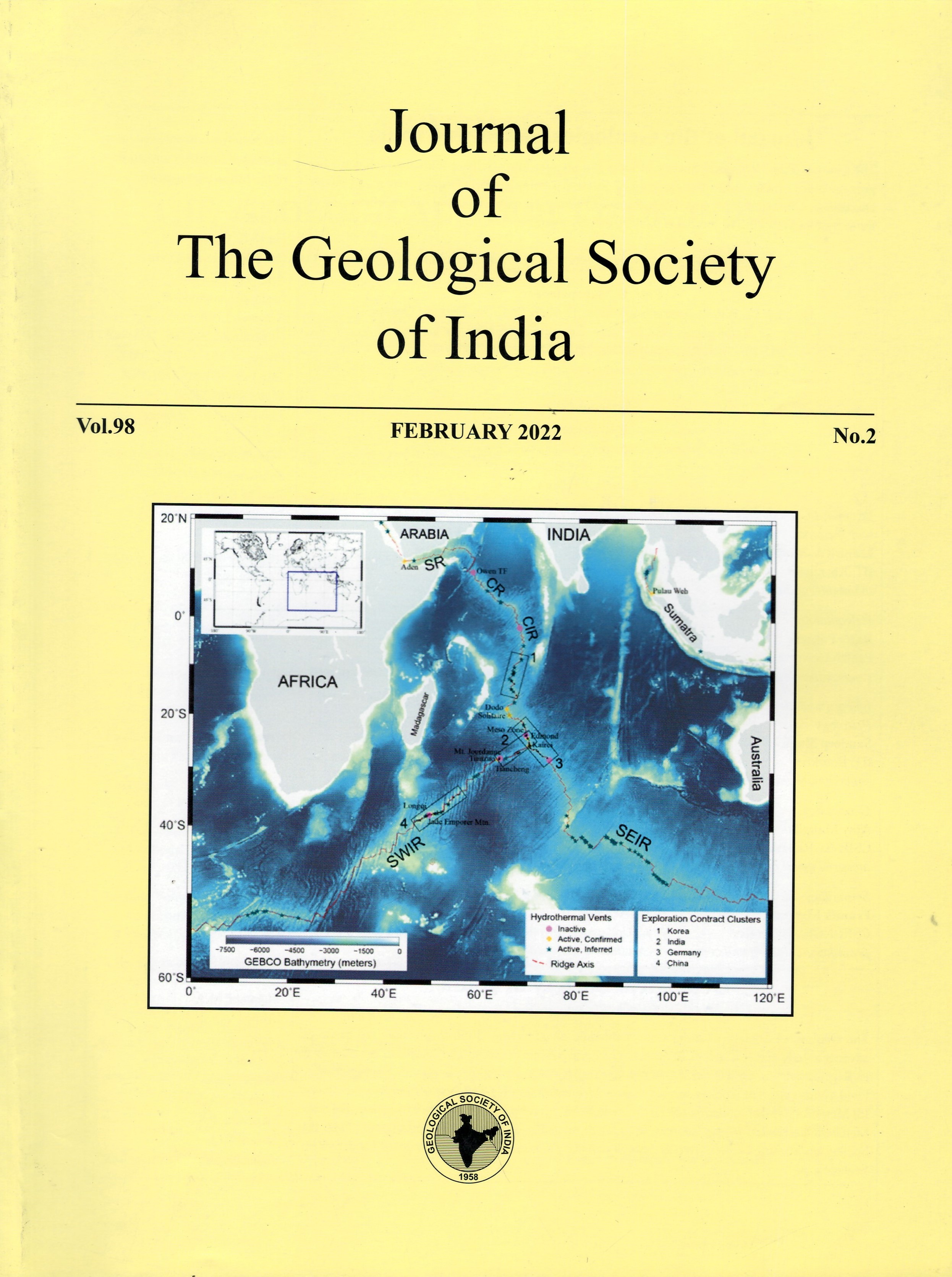Synchronous Tremor Modulation During the Passage of 2012 Super-typhoon Jelawat in Nankai Trough: By Chance or Real Consequence?
DOI:
https://doi.org/10.1007/s12594-022-1953-xKeywords:
No KeywordsAbstract
Episodic tremor and slow-slip events are sensitive to the exogenous stress perturbations process. Although tidal and remote triggering phenomena of tremors are well-established facts; however, the triggering mechanism induced by low-barometric pressure of typhoons or larger storms remains poorly addressed. In this paper, a time-synchronous tremor modulation is presented from the northern Kii Peninsula in western Japan, associated with a large Super Typhoon Jelawat, which occurred on September 30, 2012. It has been argued that such tremor excitation may not be correlated with other types of signal, such as the short-term or long-term slow-slip events, tidal effect, or remote triggering. The atmospheric low-pressure condition during the passage of super typhoon Jelawat causes vertical crustal uplift by a negative load and hence possibly enhances the thrust motion due to unclamping effects on the fault. Therefore, it is suggested that the synchronous tremor modulation process in the northern Kii Peninsula is a real consequence induced by super typhoon Jelawat.
Downloads
Metrics
Issue
Section
Downloads
Published
How to Cite
References
Bürgmann, R. (2018) The geophysics, geology and mechanics of slow fault slip. Earth Planet. Sci. Lett., v.495, pp.112–134.
Gomberg, J. (2010) Lessons from (triggered) tremor. Jour. Geophys. Res., v.115, B10302, doi:10.1029/2009JB00711.
Hsu, Y.-J., Y.-S. Chang, C.-C. Liu, H.-M. Lee, A. T. Linde, S. I. Sacks, G. Kitagawa, and Y.-G. Chen (2015) Revisiting borehole strain, typhoons, and slow earthquakes using quantitative estimates of precipitation-induced strain changes. Jour. Geophys. Res. Solid Earth, v.120, pp.4556–4571, doi:10.1002/2014JB011807.
Ide, S., K. Shiomi, K. Mochizuki, T. Tonegawa, and G. Kimura (2010) Split Philippine Sea plate beneath Japan. Geophys. Res. Lett., v.37, L21304, doi:10.1029/2010GL044585.
Ide, S. (2012) Variety and spatial heterogeneity of tectonic tremor worldwide. Jour. Geophys. Res., v.117, B03302, doi:10.1029/2011JB008840. Jolivet, R. and Frank, W. B. (2020) The transient and intermittent nature of slow slip. AGU Advances, 1, e2019AV000126. doi:10.1029/2019AV 000126.
Kodiara, S. et al., (2002) High Pore Fluid Pressure May Cause Silent Slip in the Nankai Trough. Science, v.304, 1295; doi: 10.1126/science.1096535.
Kundu, B., Ghosh, A., Mendoza, M., Bürgmann, R., Gahalaut, V.K. and Saikia, D. (2016) Tectonic tremor on Vancouver Island, Cascadia, modulated by the body and surface waves of the Mw 8.6 and 8.2, 2012 East Indian Ocean earthquakes. Geophys. Res. Lett., v.43(17), pp.9009-9017
Liu, C.C., Linde, A.T. and Sacks, I.S. (2009) Slow earthquakes triggered by typhoons, Nature, v.459, pp.833–836.
Obara, K., and Kato, A. (2016) Connecting slow earthquakes to huge earthquakes, Science, v.353(6296), pp.253-257, doi:10.1126/science.aaf1512.
Obara, K. (2002) Nonvolcanic deep tremor associated with subduction in Southwest Japan. Science, v.296(5573), pp.1679–1681.
Obara, K., Hirose, H., Yamamizu, F., Kasahara, K., (2004) Episodic slow slip events accompanied with non-volcanic tremors in southwest Japan subduction zone. Geophys. Res. Lett., v.31, L23602, doi:10.1029/ 2004GL020848.
Obara, K and Hirose, H. (2006) Non-volcanic deep low-frequency tremors accompanying slow slips in the southwest Japan subduction zone. Tectonophysics, v.417, pp.33–51.
Panda, D., Kundu, B., Gahalaut, V.K., Bürgmann, R., Jha, B., Asaithambi, R., Yadav, R.K., Vissa, N.K. and Bansal, A.K., (2018) Seasonal modulation of deep slow-slip and earthquakes on the Main Himalayan Thrust. Nature Commun., v.9(1), p.4140.
Panda, D., Kundu, B., Gahalaut, V.K., Bürgmann, R., Jha, B., Asaithambi, R., Yadav, R.K., Vissa, N.K. and Bansal, A.K. (2020) Reply to “A warning against over-interpretation of seasonal signals measured by the Global Navigation Satellite Systems”. Nature Communications, v.11(1), p.1376.
Peng, Z., Vidale, J. E., Wech, A.G., Nadeau, R.M. and Creager, K.C. (2009) Remote triggering of tremor along the San Andreas Fault in central California. Jour. Geophys. Res., v.114, B00A06, doi:10.1029/2008IB 006049.
Shelly, D.R., Peng, Z., Hill, D.R. and Aiken, C. (2011) Triggered creep as a possible mechanism for dynamic triggering of tremor and earthquakes. Nat. Geosci., v.4, pp.384–388.
Thomas, A.M., Nadeau, R.M. and Bürgmann, R. (2009) Tremor-tide correlations and near-lithostatic pore pressure on the deep San Andreas fault, Nature, v.462, pp.1048–1051, doi:10.1038/nature08654.
Thomas, A.M., Bürgmann, R., Shelly, D.R., Beeler, N.M. and Rudolph, M.L. (2012) Tidal triggering of low frequency earthquakes near Parkfield, California: Implications for fault mechanics within the brittle-ductile transition. Jour. Geophys. Res., v.117, B05301, doi:10.1029/2011JB 009036.
Vidale, J.E., Hotovec, A.J., Ghosh, A., Creager, K.C. and Gomberg, J. (2011) Tiny intraplate earthquakes triggered by nearby episodic tremor and slip in Cascadia. Geochem. Geophys. Geosyst., v.12, Q06005, doi:10.1029/2011GC003559.
Wech, A.G. and Creager, K.C. (2011) A continuum of stress, strength and slip in the Cascadia subduction zone, Nat. Geosci., v.4, pp.624–628, doi:10.1038/NGEO1215.
Zhan, W., Heki, K., Arief, S. and Yoshida, M. (2021) Topographic amplification of crustal subsidence by the rainwater load of the 2019 typhoon Hagibis in Japan. Jour. Geophys. Res.: Solid Earth, v.126, e2021JB021845. doi:10.1029/2021JB021845.
Ziv, A. and Rubin, A.M. (2000) Static stress transfer and earthquake triggering: No lower threshold in sight? Jour. Geophys. Res.: Solid Earth, v.105 (B6), pp.13631–13642.

 Bhaskar Kundu
Bhaskar Kundu






